We have all heard that old cliché: Prevention is better than a cure. As it turns out, there is no more appropriate saying than that when it comes to working with bees.
Bees sting out of instinct if they feel the hive or queen or colony is in danger. Getting stung by one or two bees is not going to kill you unless you are allergic to them – in which case you will need to seek out medical intervention urgently.
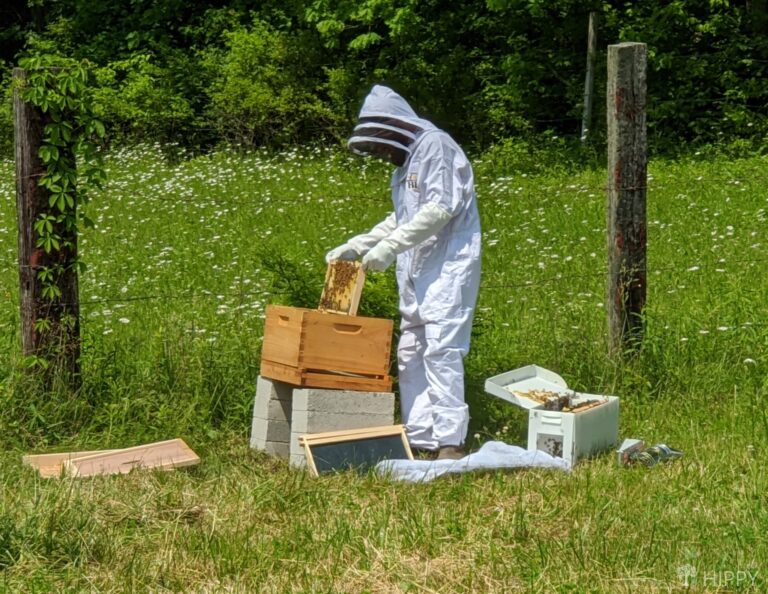
Studies have shown that it would take at least ten stings for every pound of your weight to really start to affect your health. The problem is bees communicate by the release of pheromones transmitted through their stingers.
When a single bee stings you, it releases a pheromone storm via the stinger itself. When that pheromone is released it tells every other bee in the neighborhood that there is a threat and exactly where that threat is. This is all the catalyst needed to start a stinging frenzy.
The other bees will immediately be drawn to the pheromone, and they will all sting.
I am in the unfortunate boat to know someone who was stung to death by bees. I know how quickly trouble can start.
As a result, I have a very healthy respect for bees, and I treat them like they are lions who sometimes see me as ‘food’ (foe), and sometimes barely notice me because I have implemented a good safety regime and I have a plan in place for if my bees do not want to play along with my plan on any given day.
I cannot tell you that you will never get stung. You will! Probably with each interaction you have with your bees. Knowing what to do to reduce the risk and how to deal with the stings to avoid being stung repeatedly could very well save your life.
There are things you can do when working with your bees that will reduce (not negate) the number of stings you will have to endure.
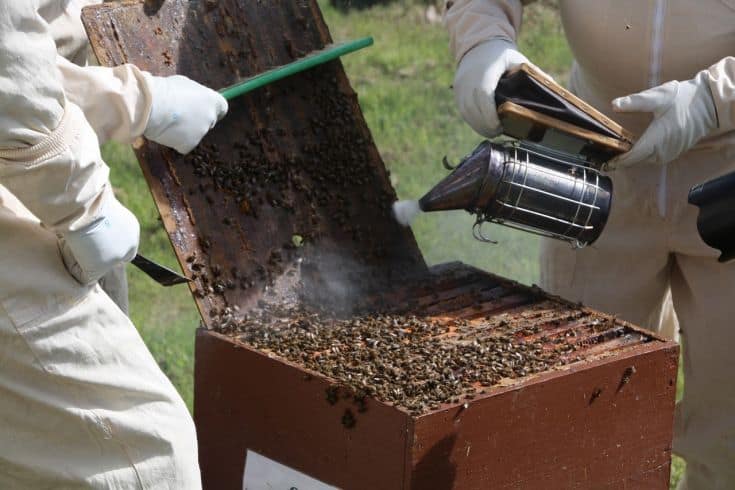
1. Use A Smoker
The easiest way to stop your bees from stinging you is to use a smoker. The smoke from a smoker causes bees to think that there is a bush fire nearby.
They immediately go into survival mode. The bees will grab as much honey as they can carry just in case they are forced to leave the hive, should the fire reach them.
Before you open your hive, give two puffs of smoke into the entrance of the hive. Once you open the lid a little, you should spray a few puffs of smoke into the hive. You do not want to use too much smoke so that the bees do not swarm to safety thinking it is too late to save their food.
If you see any bees becoming aggressive, you can use a little more smoke to calm them down, and get them back to saving the honey.
If you are stung, immediately smoke yourself to mask the smell of the pheromones as you move away and remove the stinger.
As soon as the smoke goes away, they will continue hive activity as if nothing has happened. They are effectively tricked into seeing the fire as the risk to their survival rather than you.
2. Wear Protective Gear
Wearing a bee suit will definitely reduce the risk of getting stung. Bees will still sting, but the damage to you will be much less.
There are a few things you need to remember though:
- Even though they are stinging you through the suit, they are still stinging you. This means unless you handle it correctly the other bees will follow suit, and after a honeybee stings you, it will die.
- The pheromones released in the stinger will stay on your suit for a long time – this means that in the future when you handle your bees they will still smell you as a threat unless you have thoroughly cleaned your suit
You should never wear clothing that is tight-fitting, as the stingers will easily reach you through tight-fitting clothing. Wearing layers, wearing loose-fitting clothing, or wearing thicker fabric (like denim) will make it harder for the stingers to reach your skin.
Cover as much of your body as possible. Limiting your skin exposure means the bees will have a smaller target.
3. Make Sure Your Timing Is Right
Working with bees is a balancing act of sorts. You have to predict how they will react to you coming to their hives.
Bees store up honey for themselves as food for during the winter months, when there are no food sources around. This means that you will not be well received if you try to separate them from their food supply in late fall or winter.
You should never open beehives when the temperature is below 50° F (10° C). Opening the hive will let cold air in, and warm air out. Keeping the hive warm in winter is hard for bees, therefore your they will be more agitated if you open the hive when it is cold.
Likewise, rain also has a major effect on the hive. Opening the hive when it is raining can let water in which can cause rot, mold, and disease. Bees will be more agitated if the hive suddenly gets cold and wet.
The time of day is also a factor that could put you at greater risk of being stung. You should never open the hives in the early morning or in the evening.
The temperature is lower at these times and the hive is either not yet at work or they are settling in for the night.
My recommendation is that you tend your hive between 10 AM and 2 PM. During this time, it will be warmer so the bees will be calmer, and many of the workers will be out in search of pollen and nectar, therefore there will be fewer guards on duty.
Never work in the dark. Accidents happen in the dark. If you bump or drop a hive the bees will go into full attack mode because now they will know they are at risk.
4. The Color of Your Clothing
Bees are very intelligent. Studies have shown that a bee can identify its home by the color of the hive and distinguishing marks like a sign, symbol, or even a number painted on the outside of the hive. If you move the hive, they will still know which is their home and return to it.
Because of their keen eye for detail, they are able to identify threats by color. For example, bears are brown or black; bears like honey, therefore bears are a threat. Because they see a dark color, they associate it with a threat.
You should always avoid wearing dark-colored clothing when you work with your bees. Bee suits are white because white does not elicit much of a response from bees.
Also, because of their intelligence, they know what a flower looks like and they know what to find on a flower; therefore, it is not advisable to wear anything with a floral print on it.
5. Working Under the Influence of Alcohol Is A Definite No-No
Let’s face it, nothing good comes from alcohol. Working with or even being around bees under the influence is about the dumbest thing anyone can do.
Your behavior is more likely to make you appear to be a threat to the colony and your judgment will be impaired to the extent that you may not feel that first sting and then you will not react quickly enough or appropriately to avoid being overwhelmed by the bees.
6. Leave Your Cell Phone Switched Off, or on Silent Without Vibration
Because bees communicate through vibrations having an object vibrate will cause panic in the hive. If the phone is in your pocket, or even worse your bare hand, you will become the target of the bees’ rage against this predator.
A lot of good has come from cell phones. Having a phone close by could save your life. I am certainly not telling you to leave them at home but turn off the ringer – it will draw attention – and absolutely turn off the vibrate function.
7. Bees Can Feel Your Fear So Calm Yourself Before You Go Near Them
There is a hormonal aspect to fear. If you anticipate danger, animals can sense it through the hormones your body will spontaneously release.
Going to work with your bees with a calm demeanor will keep your bees calm and less likely to sting you.
8. Cover your head
If you are not in a bee suit and you have dark hair, you should always cover your head. Bushy dark hair = bear = threat, so you may be in for some stinging.
9. Do Not Wear Sunglasses
Remember that bees are food for many other bugs and birds. Sunglasses will make you look more like a bird or bug that is looking to harm the hive.
10. Wash Your PPE Regularly
Pheromones stick around. If you do not wash your PPE, you’re literally walking into your bees’ living room smelling like danger! Wash the areas where bees have stung into the suit thoroughly.
You can also mask the smell by rubbing the area with alcohol, or spray it with your smoker to mask the pheromones. Both of these are quick solutions in the field when you do not have time to quickly remove stingers before you become a balloon to be popped.
11. Watch What You Smell Like
Because bees have a keen sense of smell they are easily affected by odors.
You should bathe daily to remove any lingering odors on your body. Food odors, interaction with other people, and even sweat can be detected by bees long after you are away from the source of those odors.
They can be attracted to perfume that smells floral; they can be confused by cologne, and they can be triggered by the smell of horses, dogs, or other animals on your clothing that they perceive to be a natural threat to them.
It is better to wear clean clothes every time you go to your hives and not to wear any deodorant, perfume, or cologne.
12. Get In and Get Out
It is important that you minimize your activity in the hive so that the bees do not become stressed out. You should always limit the amount of time your hive is open.
Get your thoughts together before you open the hive. Have a plan. Remember why you are opening the hive and what you will be checking before you open the hive.
Having a plan will limit stress, and it will also reduce the risk of crushing bees who are coming to check you out.
13. Keep Calmer Bees
Some bees are born more aggressive than others. Often this is genetic. The problem is often easily solved by replacing the queen with a calmer queen.
Queenless hives are often more aggressive and more likely to sting; you should check on the health of your queen regularly (once a month will do).
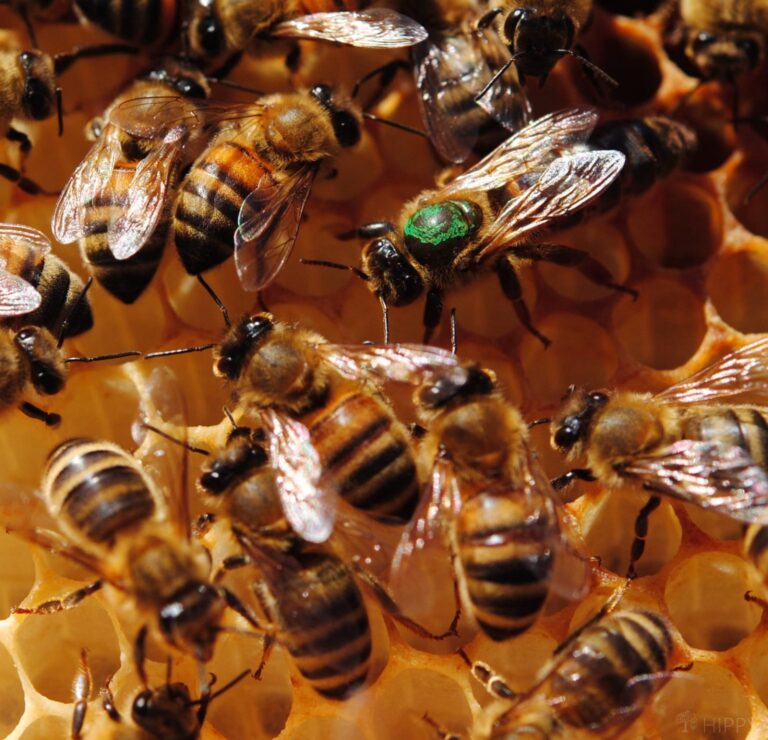
14. Do Not Make Sudden Moves
Sudden moves may seem aggressive to bees.
Imagine you were that small in such a big world. Everything would seem like a danger to you – the bigger the more dangerous.
Instinct can be a fool’s folly. When a bug invades our space, we instinctively swat it away. But if we swat at a bee, it will be interpreted as a threat, and you will be dealt with accordingly.
To remove bees off a frame, gently shake them off, or brush them off lightly with a brush.
Work carefully, and be aware of your environment. If you trip and fall, your swinging arms, your yelp of surprise, and your heavy landing can all be interpreted as danger.
15. Get to Safety
If your bees swarm or act aggressively, the best thing you can do is move away from them and get indoors – whether in a car or a building.
You will need to put as much distance between you and the bees as possible. Run! Most swarms will follow their ‘attacker’ for up to a quarter of a mile.
As you run, try to limit your arm movements. Bees will give chase, so it is important to get away sooner rather than later.
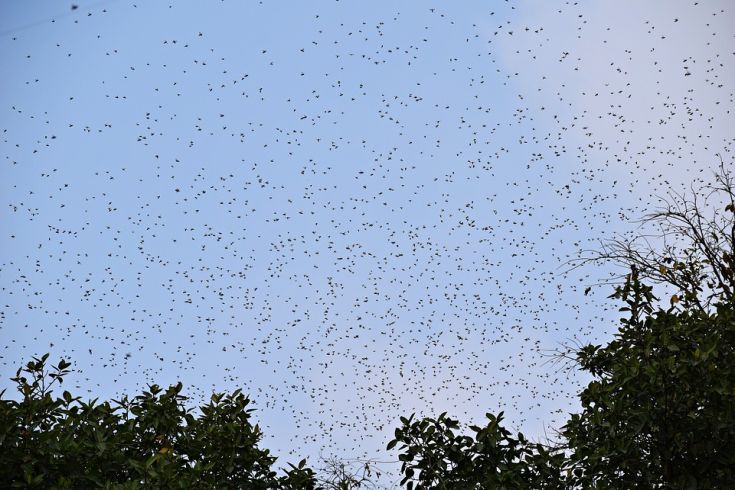
16. Heed Their Warnings
When bees come across humans, they do not usually sting immediately. Instead, hey will fly around you or bump into you to tell you they know you are there, and they do not like it!
If your bees get frisky, bumping you, that will be their one and only warning – leave or get stung.
17. Jumping into Water Will Not Help If You Are Being Stung, Get Indoors
Having a dam close by will not help you if you are being attacked. Bees are very patient. They will sting you every time you come up for a breath and they will not leave until you are gone, or it is bedtime for them.
Get away!
18. Wear Shoes
If you’re going to be around bees, you should always be wearing shoes.
When bees die, they release that pheromone that tells everyone else to come and get it. If you accidentally stand on a bee, it will release pheromones to launch an attack. If this happens to you, you will not get bumped, you will get stung.
19. Don’t Bring Drinks with You to the Hive
Bees love sugary tastes. Everyone has tried having a picnic, and had bees all over the food and in their drinks.
If you are out and about and need a drink, always use a bottle that you can open, drink, and seal closed very quickly so that the bees will not have time to process where the sweet smell is coming from. You protecting your drink is perceived as a threat to their food source.
20. Do Not Store Rubbish Near Your Hives
Storing any food supply close to or in the path between you, and your hives will increase the risk of interaction with bees out foraging.
Bees out foraging are keenly alert for danger and will respond more aggressively. Seal up garbage tightly, and keep it well away from your hives.
21. Remove the Stinger As Soon As Possible
This is probably the most important thing you can do to prevent a large-scale attack while working with your bees. Even after a bee stings you, the stinger will continue to pump venom into you.
It is important to remove the stinger as soon as possible. Keep alcohol wipes and your smoker close by. Use a credit card to immediately scrape the stinger out. Do not try to squeeze it out as this will release more poison and more pheromones.
You should wash the area with soap and water once you have removed the stinger and apply ice to limit pain and swelling.
Conclusion
Avoiding getting stung is about so much more than just saving yourself from a little pain. It is about saving a species we cannot live without.
Not all bees die after stinging. Not all bees even have a stinger. But for every one of those that do, it is our loss. We are losing one of the most effective and important pollinators on earth.
Prevent being stung by using your head and thinking ahead about what you can do to avoid being stung and where you should go and what you should do if you do get stung.
Plan your safety techniques before approaching your bees. Have a plan for what you will do if you do get stung. The more precautions you take, the less likely you are to be stung.
Let’s make the world a safer place for our bees.
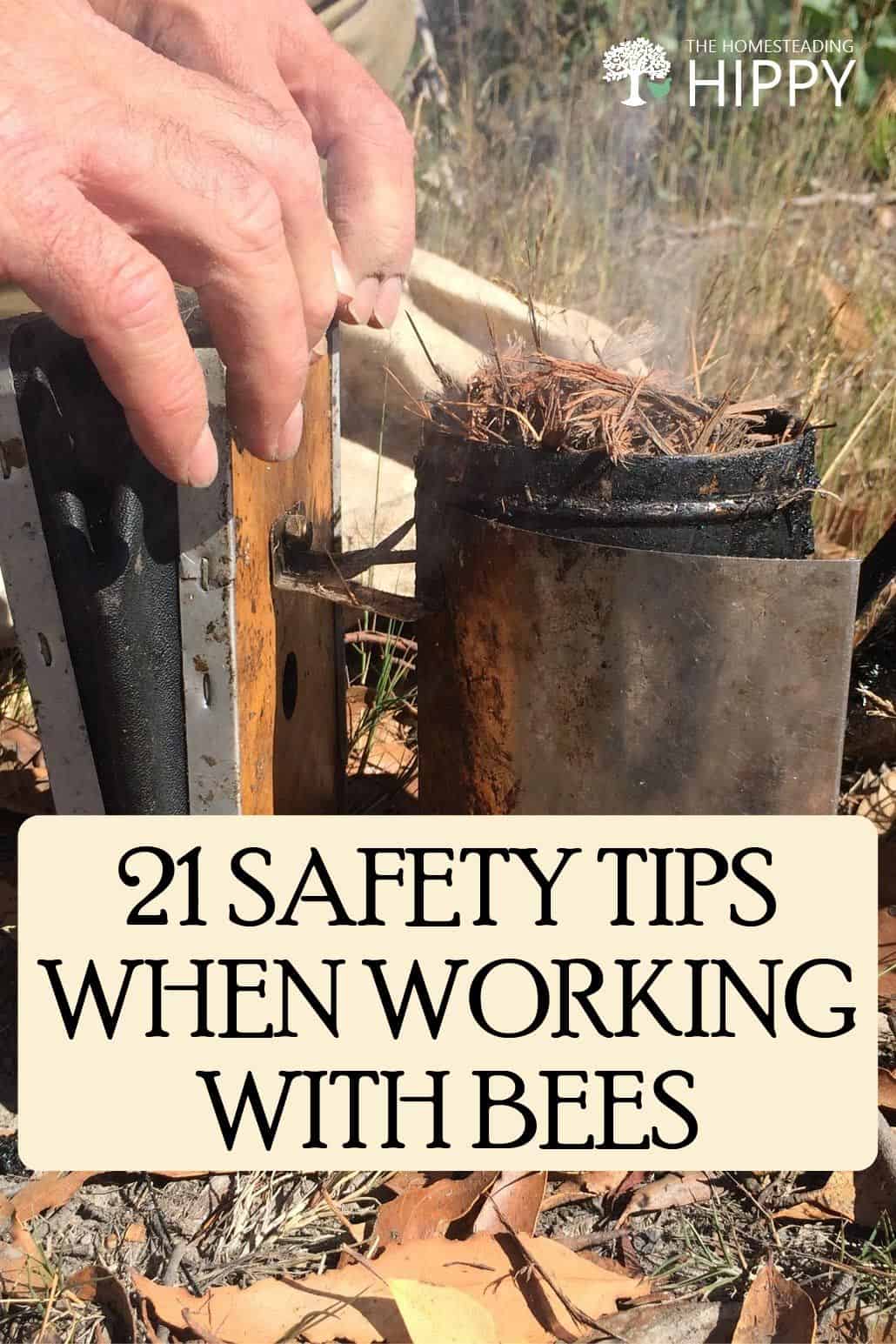

Di-Anne Devenish Seebregts was raised in an environment where daily life consisted of hiking, environmental conservation, growing fruit and vegetables, and raising poultry for meat and eggs.
She combined her passion for the writing word with her love of the pride that comes with not relying on others. She raised three children (who are now adults) to value the environment, and understand the value of being self-sufficient.
Find out more about Di-Anne on our About Us page.
